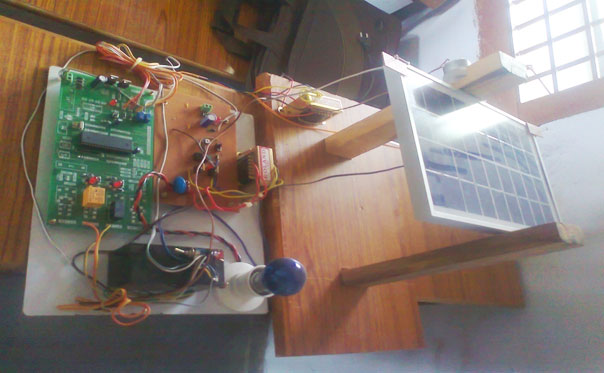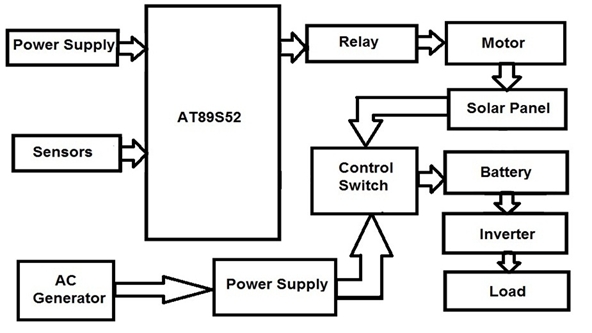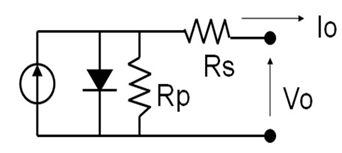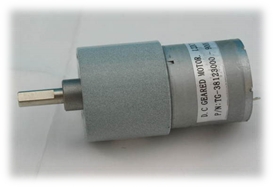With the alarming rate of depletion of the major energy resources worldwide, it has become an urgent necessity to seek for renewable energy resources that will power the future. In this context we have concentrated our focus on the research of renewable energy. Among these renewable energy resources solar energy is one of a kind. Solar power (photovoltaic) systems are a sustainable way to convert the energy of the sun into electricity. The expected lifetime of a system is 25-30 years.
With all the above information, the rapid depletion of the natural resources of the world, we would soon meet a great demand for alternative source of energy. In the very near future, experts are predicting that we will be bound to move to renewable sources of energy, solar being one of them. As long as our earth exists, the sun is there to give us unlimited solar energy. It is completely up to us how we are going to utilize this abandoned energy. Every hour, sun gives the same amount of energy to the world that the whole world uses in an entire year.
By considering all the above things and the environmental friendliness, economically sound and the ease of implementation, we thought of working on it as we believe that in the near future, our country along with the whole world will be benefited from this source of renewable energy.
1. PROBLEM STATEMENT
As we can see, there are many problems that occur in the previous type of solar tracking system. The problem that we can see here is the solar panel that is fixed in position. Because of this problem, the power that can be generated is low. The second problem is the price for the solar tracking system is very expensive for the family that use more power than usual because they need to install more than one solar panel to produce enough power. So, this project is to fix the problem that occurs here. This solar tracking system can detect a 180 degree of rotation. So, the solar panel that can be generating here is very high compare to when the solar panel can only stay in one direction. So, the families don’t have to install more than one solar panel to generate enough power. One solar panel is enough to produce a lot of power.
2. PROJECT SCOPE
This project is focused to design and build the prototype of solar tracking system that would be a starting point to build the realistic solar tracking system. Therefore, this prototype will cover the scope as followed.
- Using microcontroller (AT89S52).
- Using gear motor.
- Using two Light Dependant Resistors (LDRs) as sensors.
- Using an Inverter to run the load in the absence of the mains.
- Using a Solar battery to store the output power from the solar panel.
The Block diagram of “MULTIFUNCTIONAL SOLAR TRACKING SYSTEM” has shown below.
The design has been organized in six modules. They are
- Power supply
- Light dependant resistor
- Microcontroller
- Solar panels
- Gear motor
- Inverter
3. POWER SUPPLY
In-order to work with any components basic requirement is power supply. In this section required voltage level is 5V DC power supply. The block diagram of a typical power supply is shown below.
4. LIGHT DEPENDENT RESISTOR
Light sensors are components of circuits that are able to measure light and increase or decrease their resistance accordingly. Resistance refers to the amount of electrical current or voltage that is held back by a certain part of the circuit, in this case because of a component called a Resistor. Compared to most resistors which have a set resistance and therefore resist a specified amount of electrical current through a circuit, this one is a bit more advanced with its resistance able to be altered under varying brightness’s of light, hence being referred to as a variable resistor. It is a bilateral device, which means this conducts in both directions in same fashion.
5. MICROCONTROLLER 89S52
The AT89S52 is a low-power, high-performance CMOS 8-bit microcontroller with 8Kbytes of in-system programmable Flash memory. This device is manufactured using Atmel’s high-density nonvolatile memory technology and is compatible with the industry-standard 80C51 instruction set and pin out. The on-chip Flash allows the program memory to be reprogrammed in-system or by a conventional nonvolatile memory programmer. By combining a versatile 8-bit CPU with in-system programmable Flash on a monolithic chip, the Atmel AT89S52 is a powerful microcontroller which provides a highly flexible and cost-effective solution to many embedded control applications.
6. SOLAR POWER FUNDAMENTALS
Below figure shows a simple model of a PV cell. Rs is the series resistance associated with connecting to the active portion of a cell or module consisting of a series of equivalent cells. Rp is parallel leakage resistance and is typically large, > 100kΩ in most modern PV cells. This component can be neglected in many applications except for low light conditions.
The amazing thing about solar power is that all the electricity is generated from the material of the solar panels and the energy from the sun. The solar panels are mainly made out of semiconductor material, Silicon being the most abundantly used semiconductor. The benefit of using semiconductor material is largely due to the ability of being able to control its conductivity whereas insulators and conductors cannot be altered. The electrons of the semiconductor material can be located in one of two different bands: the conduction band or the valence band. The valence band is initially full with all the electrons that the material contains. When the energy from sunlight, known as photons, strikes the electrons in the semiconductor, some of these electrons will acquire enough energy to leave the valence band and enter the conduction band. When this occurs, the electrons in the conduction band begin to move creating electricity. As soon as the electron leaves the valence band, a positively charged hole will remain in the location the electron departed. When this occurs, the valence band is no longer full and can also play a role in the current flow. This process basically describes how Photovoltaic (PV) systems function. However, PV systems further enhance the rate at which the electrons are sent into the conduction band through the process of doping.
7. GEAR MOTOR
Gear motors are widely used in modern systems due to their high performance, long service life, and low purchase and maintenance costs. Product development has made it possible to achieve high operating pressures, excellent volumetric and mechanical efficiency, and lower noise levels. The geared instrument dc motor is ideally suited to a wide range of applications requiring a combination of low speed operation and small unit size. The integral iron core dc motor provides smooth operation and a bidirectional variable speed capability while the gear head utilizes a multistage metal spur gear train rated for a working torque up to 0.2 Nm.
8. INVERTER
The method by which dc power from the PV array is converted to ac power is known as inversion. Other than for use in small off-grid systems and small solar gadgets, using straight dc power from a PV array, module or cell is not very practical. Although many things in our homes and businesses use dc power, large loads and our electrical power infrastructure are based on ac power. This dates back to the early days of Edison versus Tesla when ac won out over dc as a means of electrical power distribution. The CD 4047 is the major element in the inverting principle. The CD4047 is capable of operating in either the monostable or stable
Circuit diagrams, source codes and project photos are given in the next pages.





